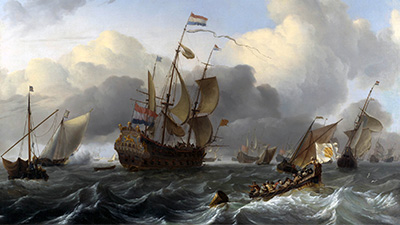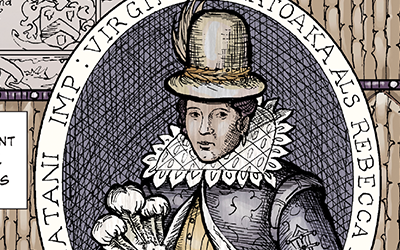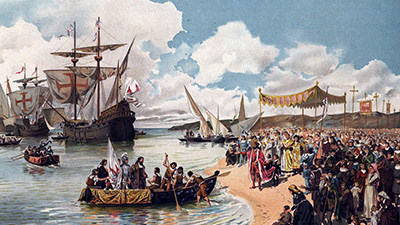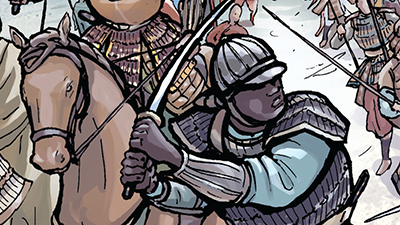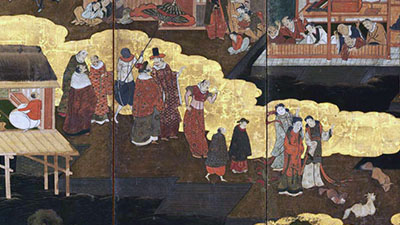Age of Exploration
Teacher Resources
Driving Question: How were European oceanic empires different from land-based empires?
Although Europeans had traveled by sea to the Americas centuries before this time, during this period their reach expanded into maritime empires. In this lesson, we will explore the beginnings of the European empires that cemented transoceanic connections.
Learning Objectives:
- Examine the characteristics of early modern oceanic empires to determine how they differed from earlier forms of empire.
- Use a graphic biography to support, extend, or challenge the overarching narratives from this time period.
Vocab Terms:
- conquest
- conquistador
- economic
- enslavement
- indigenous
- migration
- plantation
Opener: Age of Exploration
To teach this lesson step, refer to page 2 of the Lesson 3.3 Teaching Guide.
By the end of this lesson, you’ll be ready to respond to the prompt, Develop an argument that evaluates the extent to which European oceanic empires differed from land-based empires in the period 1450–1750. First, let’s figure out what that prompt even means.
Crossing the Atlantic
To teach this lesson step, refer to page 3 of the Lesson 3.3 Teaching Guide.
Check out our Reading Guide to learn about the Three-Step Reading approach.
Want to delve further into using maps in your classroom? Read this blog post to learn more.
In the fifteenth century, explorers from Europe set out across the oceans. Their voyages and conquests made some Europeans very rich and some rulers very powerful. But as you’ll see in the article and graphic bio below, not everyone shared equally.
-
Guiding Questions
-
Before you read
Preview the questions below, and then skim the article. Be sure to look at the section headings and any images.
While you read
Look for answers to these questions:
- What was the biggest motivation behind the European voyages of exploration?
- Why were the small islands off the coast of West Africa important to European expansion?
- These voyages were dangerous. Why did explorers, merchants, and rulers accept the risks?
- What advantages did joint stock companies provide?
After you read
Respond to this question: Can you think of one economic cause that led to European voyages across the Atlantic Ocean?
-
Guiding Questions
-
Before you read
Preview the questions below, and then skim the comic, paying attention to things like prominent colors, shapes, and types of text and fonts. How do you know where to start and in which direction to read? What’s in the gutters (the space between panels)? Who or what is the focus of the comic?
While you read
- How did Amonute become important to the English settlers in Virginia? What are the key elements of the story John Smith told about her?
- How does Karen Ordahl Kupperman evaluate John Smith’s story of Amonute?
- What are the key arguments made by the oral historians of the Mattaponi people, as presented in this biography?
- What are some doubts anthropologists like Helen Roundtree raise about the oral tradition version of events?
- How does the artist use art and design to show that there are different stories about Amonute?
After you read
Respond to these questions: Which version of Amonute’s relationship with English settlers do you think is more likely to be accurate? Why?
Routes to the East
To teach this lesson step, refer to page 4 of the Lesson 3.3 Teaching Guide.
Could your students use more support for reading graphic biographies? Check out this tool!
European navigators also traveled to the Indian Ocean in search of new trade opportunities. In this article and graphic bio, you’ll read about their interactions with powerful states and a flourishing network of trade.
-
Guiding Questions
-
Before you read
Preview the questions below, and then skim the article. Be sure to look at the section headings and any images.
While you read
Look for answers to these questions:
- What was the immediate impact of Europeans arriving in the Indian Ocean?
- How did the rulers of Indian Ocean states view the arrival of the Portuguese?
- Why were diaspora communities important to the Indian Ocean world?
- What role did the Armenian diaspora have in extending the influence of European empires in the Indian Ocean?
After you read
Respond to this question: What role did states play in the expansion of maritime exploration during this period?
-
Guiding Questions
-
Before you read
Preview the questions below, and then skim the comic, paying attention to things like prominent colors, shapes, and types of text and fonts. How do you know where to start and in which direction to read? What’s in the gutters (the space between panels)? Who or what is the focus of the comic?
While you read
- Where was Yasuke likely from and how did he get to Japan?
- What was Yasuke’s relationship with Oda Nobunaga?
- What happened to Yasuke after Oda Nobunaga was killed?
- What else do we know about Yasuke?
- How does the artist’s depiction of Yasuke change across the page?
After you read
Respond to this question: How does this biography of Yasuke support, extend, or challenge what you have learned about oceanic connections and networks in this period?
Oceanic Empires
To teach this lesson step, refer to page 6 of the Lesson 3.3 Teaching Guide.
As you work through course activities, make sure they’re accessible to all students. Read our OER Project Differentiation Guide to learn more.
European sea travel transformed trade and imperial expansion—but it also produced enormous social change and upheaval. Use this article and activity to evaluate whether there was anything new about this type of empire.
-
Guiding Questions
-
Before you read
Preview the questions below, and then skim the article. Be sure to look at the section headings and any images.
While you read
Look for answers to these questions:
- What were the main empires that took part in the maritime expansion in this period?
- What were the main regions that these empires expanded into during this period?
- Who were the “private actors” in this phase of imperial expansion? Can you note any examples?
- What were some of the main reasons for the imperial maritime expansions in this period?
- What product was in demand in Europe and drove plantation economies across the Atlantic Ocean?
After you read
Respond to this question: How did the new global networks described in this article change societies around the world?
Comparing Empires
Continue your exploration of oceanic empires by comparing them to another kind of empire—gunpowder empires. What did they have in common? And what was different?
Closer: Age of Exploration
To teach this lesson step, refer to page 8 of the Lesson 3.3 Teaching Guide.
Teaching students to parse prompts is just one part of helping students become strong historical writers. Read this blog post to learn more.
Now that you’ve met plenty of land-based empires, it’s time to return to the prompt you parsed at the beginning of the lesson.
The Omani and Comanche Empires
To teach this lesson step, refer to page 8 of the Lesson 3.3 Teaching Guide.
This lesson focused on how oceanic empires were different from their land-based counterparts. But it’s time to challenge that idea with two very nontypical empires: the Omani and Comanche.
-
Guiding Questions
-
Before you watch
Preview the questions below, and then review the transcript.
While you watch
Look for answers to these questions:
- What makes the Omani Empire different from other Islamic empires?
- What areas did the Omani Empire cover at its peak?
- How did the Omani Empire come to be an empire?
- What are two key differences between the Omani Empire and most other empires?
- How did the Omani Empire change East Africa in the long term?
After you watch
Respond to these questions: Do you think the Omani Empire was actually an empire? Why or why not?
Key Ideas
-
Guiding Questions
-
Before you watch
Preview the questions below, and then review the transcript.
While you watch
Look for answers to these questions:
- What do the Comanche and the Mongols have in common?
- What was unique about Comanche leadership, and how did this help them build their empire?
- Why were horses so important to the Comanche Empire?
- How did the Spanish colonizers relate to the Comanche?
- How did the Comanche form broader networks and communities with other Indigenous groups?
After you watch
Respond to this question: Do you think the Comanche Empire was actually an empire? Why or why not?


